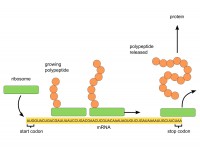Physics-based model improves our understanding of the genetic code

This cross-disciplinary work brings together physics and biology in order to understand how the genetic code determines the rate of protein production in the cell.
Proteins are of paramount importance to normal cell functioning, and their production consumes a very large proportion of the cell's total energy. Despite the evident role of evolution in shaping accurate and fast protein production in fast-growing organisms such as bacteria and yeast, identifying the traits of the genetic code controlling the amount of proteins in cells has so far remained elusive.
The authors solve a mathematical model for the motion of ribosomes, molecular machines that assemble proteins according to a specific gene sequence. The process resembles a single-file traffic, in which the flow of ribosomes may be hindered by a stalled ribosome in front. Physicists have been studying this model for more than forty years, but until now, the lack of its mathematical solution has delayed any significant progress on predicting protein production rates.
The solution, which is valid in the biologically relevant regime, allows identifying regions of the gene sequence that may affect ribosome traffic and thus the overall rate of protein production in the cell.

